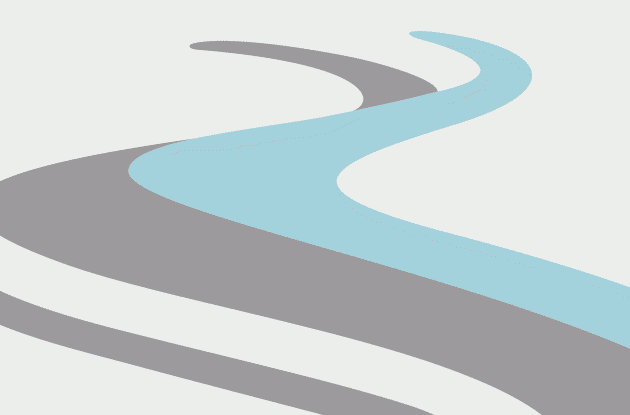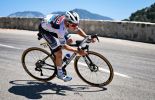Neck and Back Pain in Bicycling
Improper bicycle fit can lead to dysfunction, impaired performance, and pain.
Introduction
Participation in cycling has steadily increased over the past ten years. Individuals looking for a low-impact alternative to running and other aerobic activity have found cycling to meet these needs. In fact, the American Bureau of Transportation Statistics estimates that more than 49 million Americans ride bicycles at least monthly, with over 5 million people riding at least 20 days/month. [BTS] As a result, the number of cycling-related injuries has also risen, with the majority due to overuse. Improper bicycle fit, technique, or training patterns may either cause or exacerbate these injuries, and can lead to dysfunction, impaired performance, and pain.
Neck and back pain are common in cyclists because of the body's positioning during riding. Several studies have demonstrated that neck and back injuries are the most common overuse injuries evaluated following six to eight-day distance bicycle tours (Figure 1). [Wilber/Weiss AJSM/Dannenberg] Wilber, et al. found that 44.2 % of male and 54.9% of female recreational cyclists presented for medical treatment of neck pain, while approximately 30% presented with back pain. [Wilber] Weiss also reported that 66.4 % of recreational cyclists reported neck and shoulder symptoms following an 8-day, 500-mile bicycle tour. [Weiss] The prevalence of such injuries, especially in recreational riders, suggests that more understanding is needed by riders and their health care providers to prevent such injuries by proper education and fit, and treating these injuries when they occur. A better understanding of the pathologic mechanism of musculoskeletal overuse injuries, specifically in cyclists, is key in developing good preventive and treatment strategies for the neck and back injuries they frequently experience.
Overuse Injuries
Overuse injuries occur when a tissue accumulates damage caused by repetitive sub-maximal loading. Repetitive activity fatigues a specific structure, such as tendon or bone. Without adequate recovery, micro trauma stimulates an inflammatory response, causing the release of vasoactive substances, inflammatory cells, and enzymes that damage local tissue. Over time, this trauma leads to clinical injury. Continued activity produces degenerative changes that result in weakness, loss of flexibility, and chronic pain. Thus, in overuse injuries, the problem is often not acute tissue inflammation (tendonitis), but chronic degeneration, or tendinosis. [Khan]
Pain in overuse injuries typically has an insidious onset. However, it may also have an acute-on-chronic presentation. Overuse injuries most likely occur when an athlete changes the mode, intensity, or duration of training. Biomechanical (intrinsic) factors and equipment or training regimen (extrinsic) issues are the main contributors to overuse injuries. It is the extrinsic issues that cause most of the overuse injuries in cyclists. [Mellion, Team Physician]
While problems such as fractures, dislocations, and ligament ruptures usually only occur after major trauma, overuse injuries are much more common. Thus, these factors should be considered when evaluating neck and back pain as well as all cycling-related injuries and one must consider bicycle fit, training distance and intensity, and anatomic factors to determine the exact mechanism. Often, adjustments in the bicycle or the individual's exercise regimen may be all that is necessary to ameliorate their symptoms and accelerate the healing process.
Bicycle Anatomy
Bicycles consist of a frame, handlebars, brakes, wheels, pedals, gears, and other components (figure 2). The key part is the frame, made of metal or metal alloys such as titanium, aluminum, steel, or carbon. Frames can be thought of as two triangles: the front triangle consists of the top tube, the seat tube, and the down tube; the chain stay, seat stay, and seat tube compose the rear triangle. Handling and maneuverability are affected by the angles within each of these triangles. Racing bicycles have a more upright geometry, with larger angles for increased maneuverability. Touring bicycles have a flatter geometry, which much less pronounced angles for easier handling and comfort. In contrast, mountain bikes, designed for maneuverability and stability, have a geometry that provides for a lower center of gravity, resulting in much smaller angles in the frame.
Frame size is determined by the seat tube length in centimeters (mountain bicycles in inches), measured from the center of the bottom bracket to the center of the top tube or from the top of the bottom bracket to the top of the top tube. The top tube length affects the reach of the rider and is an important measurement for proper frame fit. The "virtual top tube" measurement is the top tube plus stem length, which equals the total reach. While different bicycles are designed to position the rider differently (touring bikes allow for an upright ride, with less extension placed on the back, while racing and mountain bikes focus on the need for a more stream-lined ride, thus the rider is more "laid out" and has to extend his or neck more. These differences impact what type of pain the rider experiences.
Neck and Upper Back Pain
Neck pain can be exacerbated by several factors to include riding position, technique, and comorbid conditions. In the cycling position, the neck is extended and the back flexed for prolonged periods. Riding in drop handlebars for long periods increases the load on the arms and shoulders as well as hyperextension of the neck, leading to muscle fatigue and pain. If the virtual top tube length (top tube plus stem length) is too long for the rider, or if aero bars are used, hyperextension of the neck is further increased. Prolonged hyperextension of the neck and associated muscle strain may lead to trigger points in the muscles of the neck and upper back. Trigger points are small rubbery knots that form in muscle and adjacent muscle sheaths (fascia), which send pain signals to the brain and contribute to a pain-spasm-pain cycle. Trigger points are frequently caused by direct blunt trauma, or by repetitive microtrauma, as is seen in overuse athletic injuries. Certain techniques common to cyclists may also cause trigger point pain. Cyclists frequently present with pain in their left levator scapula caused by frequently looking over their left shoulder for oncoming traffic. Additionally, comorbidities must be assessed; in older riders, for example, it is prudent to question about radicular symptoms because a certain degree of neck pain may be secondary to arthritis in the cervical spine.
Thoracic outlet syndrome (TOS) is a less common, but important cause of neck pain. TOS may present with tingling in the fingers; pain in the neck, shoulder, and arm; headaches in the back of the head; weakness of the arm and hand; cold or cyanotic hands. These symptoms may worsen with such activities as elevating the arm to comb or blow-dry one's hair or drive a car. TOS is most often produced by hyperextension neck injuries, typically traumatic, but may also be caused by repetitive over hyperextension of the neck.
Riders suffering from neck pain should inspect the fit of their bicycle. One way to reduce neck hyperextension is by raising the handlebars, or using handlebars with a shallower drop. Another method is to reduce the virtual top tube length, by using a shorter stem. Moving the saddle forward also reduces virtual top tube length, but the rider should be cautious as improper fore/aft saddle position can lead to knee pain.
Changes to riding technique can also help with neck pain. A rigid riding position transmits more shock directly to the neck and shoulders. Riding with unlocked elbows and changing hand position (i.e. from drops to brake hoods) can alter neck posture minimizing pain. Although some handlebar materials provide a softer or stiffer ride, there is currently no evidence that changing handlebar material affects neck pain. Educating cyclists to frequently stretch their neck during more leisurely parts of the ride may reduce the frequency and severity of neck pain.
Other factors contributing to neck pain are helmet fit and handlebar width. The helmet should be worn so that it is snug, stable, and level on the head with the front rim barely visible to the rider's eye. Improperly fitted helmets may cause excessive neck extension in order to maintain visibility, resulting in further neck pain as described above. Handlebars should be shoulder width apart (measured from acromion to acromion across the anterior chest) and comfortable. Handlebars that are too wide may cause excessive trapezius and rhomboid strain leading to muscle spasm and pain. (Burke)
Back Pain
Back pain is also very common in cycling. Cycling position leads to prolonged back flexion, resulting in muscle pain in the unconditioned back. The low back is the primary muscle group generating power and controlling the movement of the bicycle. If the back is not well conditioned and flexible, muscle fatigue and strain will occur, leading to pain.
The virtual top tube length and the amount of spinal flexion in the rider's back should be investigated in cyclists with back pain. If the handlebars are too low, the flexion (lordosis) of the spine is exaggerated resulting in increased pressure on the lumbar spine. If the top tube length is too short, the sacral spine will flex, increasing pressure on the intervertebral disks. Ensuring that the handlebar height and top tube length are correct should help minimize back pain (discussed below).
Pelvic position also contributes to back pain, as a misaligned pelvis will cause strain to the back musculature. Tight quadriceps will tend to tilt the pelvis forward, while tight hamstrings predispose to backward pelvic tilt. The Thomas test measures the degree of flexibility of the hip flexors, while the popliteal angle can objectively assess hamstring flexibility. Pushing large gears or extended hill climbing may fatigue the gluteus and the hamstrings, causing the pelvis to tilt backwards, aggravating the back musculature, causing pain. Also, the strength of the abdominal muscles is critical to maintaining stable pelvic positioning. Core muscle group strengthening and lower extremity stretching will help with proper pelvic positioning and lead to pedaling efficiency.
Researchers have reported that low back pain among men and women cyclists occurs at rates of up to 50% [Salai] and may be related to the cyclist's position on the bicycle. To help reduce the incidence of back pain some have suggested that a forward pelvic tilt is favorable as it decreases lumbar flexion and tensile stress to the longitudinal ligaments of the lumbar spine. [de Vey] Although there is evidence to show that anterior pelvic tilt would reduce the incidence of low back pain, it may increase pressure on the anterior perineum, and may also contribute to increased hyperextension of the neck and neck pain. [Bressel]
Abnormal pelvic tilt is not the only cause of lower back pain in cyclists. The lumbosacral junction, a point of support from which the power of the legs is generated and transmitted to the pedals, may also be a source of pain an injury when there is an improper fit between rider and bicycle. The cyclist's position on the bicycle compresses the anterior portion of the intervertebral disk and opens up the posterior side. This tenses the posterior ligamentous complex, leading to low back pain. During load-bearing activity, increased abdominal pressure can protect against this by increasing spinal stability and reducing discal load. [Nachemson] However, because of respiratory needs, the cyclist cannot employ this defense mechanism.
Bicycle Fit
The virtual top-tube length is the most important fit factor for neck and back pain. Proper reach gives you easier breathing, better neck and lower back comfort, weight distribution, and bicycle handling. "Ideal position" varies here more than anywhere else for cyclists, depending on riding style, flexibility, body proportions, and frame geometry, among others. Unfortunately, there is no set formula for sizing the top tube and stem. The top tube length contributes to the distance from the seat to the handlebars, and therefore should vary with the rider's size. Both arm length and torso length figure into the proper distance from seat to handlebars. After the frame is constructed, the distance from seat to handlebars can be adjusted by replacing the stem. However, use of a stem shorter than 40mm or longer than 140mm alters the stability of the bicycle, so it is of some importance that the top tube length be as close to correct as possible.
One indicator of proper reach comes from glancing down at the front hub while riding in the drop handlebars; your view of the front hub should be obstructed by the handlebar. In another fit technique your elbows, bent at 65-70 degrees with your hands in the drops, should be within an inch or two of your knees at the top of your stroke. [Lemond]. Finally, Bicycling Magazine recommends that while in a comfortable position with hands on the brake hoods, looking straight ahead, that a plumb bob dropped from the tip of the nose should intersect the stem.
As much as possible, forward lean toward the handlebars should come from the pelvis rotating toward the handlebar rather than the back bending. Ideally, the back will be straight, pelvis tilted with no loss of breathing efficiency.
Handlebar Height
If the handlebars are too low, excess lordosis of the lumbar spine and increased hyperextension of the cervical spine occurs, leading to both low back and neck pain. Measure the handlebar height by holding a yardstick on the seat so that the yardstick extends over the bars noting the difference between the seat and the bars. Ideally, the handlebars should be even with the seat or between even and 4 centimeters lower. Extremely fit, flexible cyclists may have their handlebars up to 5-9 centimeters below the level of the seat [Lemond/Bicycling]. The competitive cyclist will have their bicycle adjusted to fit how they individually ride.
Stretching and Strength Training
Because cycling demands prolonged back flexion and neck extension, ensuring that your neck and back are flexible is very important. The cycling process demands repetitive hip and leg flexion anchored by a stable pelvis. Core strength and stability should be sought for all riders. A physical therapist or a sports medicine provider can easily teach common back and neck stretches and back core-strengthening exercises.
Conclusion
Neck and back pain is a common complaint among cyclists. By making a few select adjustments to the bicycle added to a core strengthening and stretching program, this ailment can be easily remedied. Proper fit should be ensured; this is accomplished by relieving over extension by using handlebars with less drop, shorter stem, elevating the stem or adjusting the seat position. Changing hand position frequently, relaxing the elbows, and varying head position will decrease the likelihood of developing neck and back pain. As more people seek low-impact ways to improve and maintain their cardiovascular fitness, physicians will no doubt see more patients who have neck and back pain related to bicycling. By learning a few simple bike-fitting techniques, physicians can treat and prevent many common problems of this popular activity.
References
US Department of Transportation: Bureau of Transportation Statistics: Bicycle use among adult US residents. OmniStats 2002;2(6):1-3
Wilber CA, Holland GJ, Madison RE, et al. An epidemiologic analysis of overuse injuries among recreational cyclists. Int J Sports Med 1995: 16: 201-6.
Weiss BD. Nontraumatic injuries in amateur long distance bicyclists. Am J Sports Med 1985; 13(3): 187-192.
Dannenberg AL, Needle S, Mullady D, et al. Predictors of injury among 1638 riders in a recreational long-distance bicycle tour: cycle across Maryland. Am J Sports Med 1996; 24(6): 747-753.
Conti-Wyneken AR. Bicycling injuries. Phys Med Rehab Clin NA 1999; 10(1): 67-76.
Mellion MB: Bicycling, in Mellion MB (ed): Team Physician's Handbook. Philadelphia, Hanley & Belfus, 2002, pp 52-70
Mellion MB. Neck and back pain in bicycling. Clin Sports Med 1994; 13(1): 137-164.
Mellion MB. Common cycling injuries: management and prevention. Sports Med 1991; 11(1): 52-70.
Burke ER. Proper fit of the bicycle. Clin Sports Med 1994; 13(1): 1-14.
Thompson MJ, Rivara FP. Bicycle-related injuries. Am Fam Phys 2001; 63(10): 2007-2018.
Sanner WH, O'Halloran WD. The biomechanics, etiology, and treatment of cycling injuries. J Am Podiatr Med Assoc 2000; 90(7): 354-376.
Salai, M., T. Brosh, A. Blankstein, A. Oran, and A. Chechik. Effect of changing the saddle angle on the incidence of low back pain in recreational bicyclists. Br. J. Sports Med. 33: 398-400, 1999.
de Vey Mestdagh, K. Personal perspective: in search of an optimum cycling posture. Appl. Ergon. 29: 325-334, 1998.
Bressel E, Larson BJ. Bicycle seat designs and their effect on pelvic angle, trunk angle, and comfort. MSSE 2003; 35(2): 327-332.
Nachemson AL. The lumbar spine: an orthopaedic challenge. Spine 1976;1:59.
Khan KM, Cook JL, Taunton JE, et al. Overuse tendinosis, not tendonitis. Phys Sports Med 2000; 28(5): 31-46.
Lemond G, Gordis K. Greg Lemond's Complete Book of Bicycling. New York City, Perigree Books, 1990, pp 118-145.








